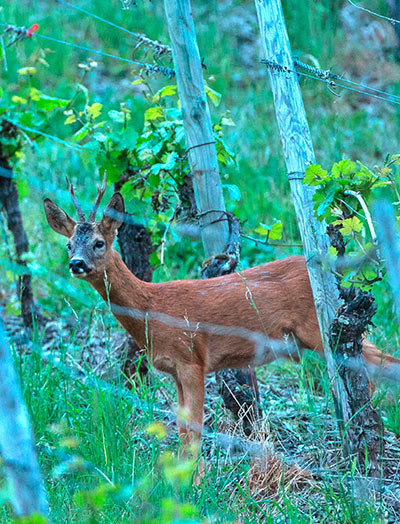
Roe deer prefer habitats with plenty of different species and structures, which include wine-growing areas. They do not cause any relevant damage to classic crops. Not so in vineyards. In April and May, they nibble the fresh shoots after the vines have blossomed. Bucks mark their territories, causing fraying damage to vines. In September, they love to eat the grapes. Yet other wild cloven-hoofed animals in the region appreciate grapes, too. Another problem is the rooting damage caused by wild boar in the often green lanes between the vines.
Damage like this can be avoided with a properly set up and maintained
AKO electric fence. The power is supplied by a powerful
12 V AKO electric fence device. If a 230 V power supply is ensured, then
230 V AKO power packs or
AKO Duo electric fence devices can also be used. For long fences with multiple wires and where heavyn vegetation is to be expected, we recommend a pulse energy of more than 5 Joules. Optimum earthing is essential.
Please note:
Due to the specific terrain of vineyards (e.g. steep slopes, terraces), an electric fence must be set up so that the animals cannot jump over the fence from above. Roe deer like to slip under or between obstacles.
Recommendations: to keep away roe deer and, where necessary, wild boar, three wires are tensioned at 20, 40 and 60 cm from the ground. A
wooden post should be sunk at the corners and, depending on the fence length and for stability, halfway along each side of the vineyard, to which insulators are screwed. 90 cm long
AKO plastic posts with integrated
wire eyelets are installed in between (depending on the terrain) at intervals of 6 to 8 metres depending on the height of the fence. The wires are tensioned on the
wooden posts, whereas they only need to be inserted into the eyelets of the
plastic posts. On stony ground, you will need to prepare holes using an iron rod or auger. The electric fence absolutely must be placed at the main wild animal interchanges and can then protect the vineyard in a U-shape. You can then decide for yourself whether to fence in the “harmless” side.